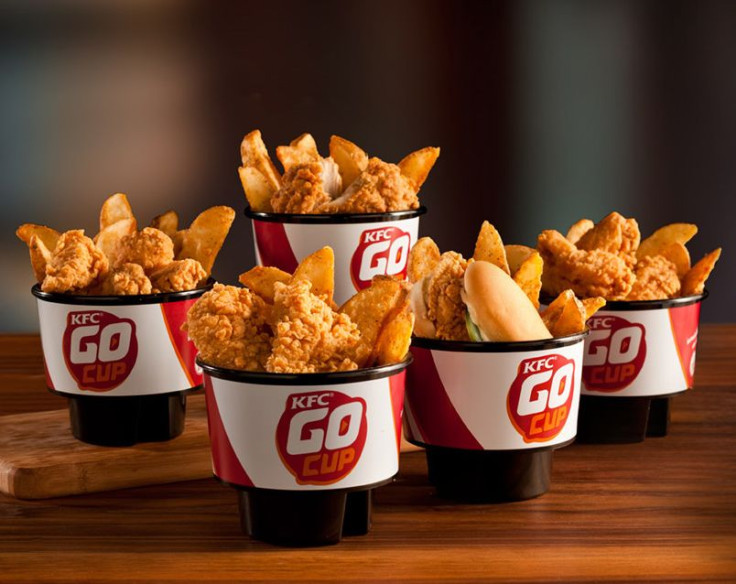KFC Go Cups Turn Cup Holders Into Chicken Dispensers: What Happened To Fast Food’s Health Trend?

The KFC Go Cup is many things: portable, convenient, maybe even a bit edgy. But one thing it’s not is a conformist. The ninth largest fast-food chain unveiled its latest creation amid a host of quick-service restaurants dropping unhealthy menu items for fresher, wholesome alternatives. So why hasn’t KFC joined the fight?
McDonald’s recently announced plans to roll out fresh fruit and vegetables as alternative side dishes. Burger King just cooked up a new line of low-calorie “Satisfries.” Subway offers its line of Fresh Fit choices, which are certified by the American Heart Association. Meanwhile, KFC has released 540-calorie bowls of chicken and French fries that contain 28 grams of fat, more than half your day’s worth of sodium, and can be unceremoniously devoured in heavy traffic.
"People are already eating on the go," a spokesperson from KFC told Yahoo! Shine, "and we're trying to make that as easy as possible."
People are eating on the go — 70 percent of them, in fact, according to an Exxon Mobil study. Insofar as KFC is trying to appeal to a potentially lucrative financial market, its efforts seem pointed in the correct direction. But in terms of meeting consumers’ health demands, the evidence weighs heavily on the side of keeping chicken tenders off the streets.
A 2009 report from the National Highway Traffic Safety Administration shows that eating behind the wheel can increase the risk of an accident by 80 percent. Fried foods make the problem even stickier, as people reaching for greasy pieces of chicken must also blindly navigate for a napkin, lest they grip a slippery wheel. Alternatively, they may lick their fingers or wipe them on a pant leg. In either case, drivers must pay attention to things other than the road ahead of them, thereby raising their risk for an accident.
Fortunately, KFC argues that it has solved this problem.
"The food is above the edge of the container so it's as convenient to get to as possible,” the spokesperson said. (What happens once someone eats the top layer of food is unclear.)
Aside from the direct consequences of eating food high in fat and sodium, distracted eating has the potential to lead to distracted overeating. One study published early this year found inattentive eating habits — mindless snacking on the couch, eating fried chicken at rush hour — can lead to overconsumption, due to the brain’s inability to sense how much food has been eaten. “Removing visual information about the amount of food eaten during a meal increased immediate intake,” the researchers wrote.
Moreover, a paper from Harvard University’s School of Public Health concluded that distracted eating can lead to weight gain. Because your brain takes 20 minutes to register fullness — once the appropriate mix of hormones in your gut tells it that it’s had enough — your desire to eat more may subside if you simply were to wait. Of course, the very idea of fast food discourages this.
“If you aren’t mindful of what’s going into your mouth, you don’t process that information,” notes Howard LeWine, M.D., chief medical editor of internet publishing at Harvard Health Publications. “That means it doesn’t get stored in your memory bank. And without a memory of having eaten, you are more likely to eat again sooner than you might have if you ate mindfully.”
This is not to say KFC doesn’t want its customers being attentive: the chain has launched a promotional campaign among Instagram users, urging them to take a picture with its Go Cup and post with the hashtag, #GoCupGo. The best photos will receive prizes, according to the contest’s site.
Entrants, however, “may not show or promote unlawful activities or any activities that may appear unsafe or dangerous." So, depending on whom you ask, snapping a photo while driving may be grounds for disqualification.



























